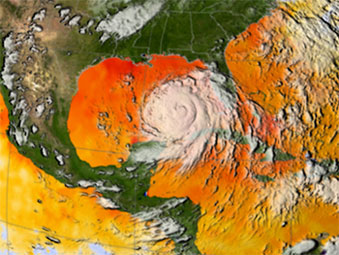Global warming causing stronger hurricanes confirms study
Rhett A. Butler, mongabay.com
March 16, 2006
The link between warmer ocean temperatures and increasing intensity of hurricanes has been confirmed by scientists at the Georgia Institute of Technology.
Last year, two studies published in the journals Nature and Science found a strong correlation between rising tropical sea surface temperatures and an increase in the strength of hurricanes.
The Nature study, published in July 2005 by Kerry Emanuel, an atmospheric scientist at Massachusetts Institute of Technology, found that hurricanes in the north Atlantic and the north Pacific Oceans have grown significantly more powerful and destructive over the past three decades. Emanuel reported that “both the duration of the storms and their maximum wind speeds have increased by about 50 per cent since the mid-1970s”, developments that are mirrored by increases in the average temperatures at the surface of the tropical oceans. At the time of publication, Emanuel warned that global climate change might increase the effect of hurricanes still further in coming years.
In September, following the destruction wrought by Hurricane Katrina, Science published study by researchers at the Georgia Institute of Technology and the National Center for Atmospheric Research (NCAR) indicating that the number of Category 4 and 5 hurricanes worldwide has nearly doubled over the past 35 years, from about 10 Category 4 and 5 hurricanes per year in the 1970s to 18 per year since 1990.
 Warm ocean waters fuel hurricanes, and there was plenty of warm water for Katrina to build up strength once she crossed over Florida and moved into the Gulf of Mexico. This image depicts a 3-day average of actual sea surface temperatures (SSTs) for the Caribbean Sea and the Atlantic Ocean, from August 25-27, 2005. Every area in yellow, orange or red represents 82 degrees Fahrenheit or above. A hurricane needs SSTs at 82 degrees or warmer to strengthen. The data came from the Advanced Microwave Scanning Radiometer (AMSR-E) instrument on NASA’s Aqua satellite. The GOES satellite provided the cloud data for this image. Image Credit: NASA/SVS. |
According to a news release from Georgia Tech, the latest study “sought to determine whether factors other than sea surface temperatures could be significantly contributing to this 35-year trend.” University researchers Carlos Hoyos, Paula Agudelo, Judith Curry and Hai-Ru Chang looked at three other factors — changes in wind speed and direction with height, known as vertical wind shear; humidity in the lower atmosphere; and the tendency of the winds to rotate in a cyclonic direction, called zonal stretching deformation — and found that sea surface temperatures were the most significant influence on the increase in both global hurricane intensity as well as the intensity of the North Atlantic hurricanes.
“With this new paper, we firm up the link between the increase in sea surface temperatures and hurricane intensity, which has been a key issue in the debate about whether global warming is causing an increase in hurricane intensity,” said Curry, professor and chair of the School of Earth and Atmospheric Sciences at Georgia Tech.
The new study appears online in the March 16 edition of Science Express (www.scienceexpress.org).
Related
Hurricane could hit Los Angeles, San Diego: San Diego has been hit by hurricanes in the past and may be affected by such storms in the future according to data from the National Oceanic and Atmospheric Administration (NOAA). While a hurricane in San Diego would likely produce significantly less damage than Hurricane Katrina in New Orleans, it could still exact a high cost to Southern California especially if the region was caught off guard.
This article used quotes and information contained in press materials from Georgia Tech, MIT, and NCAR.